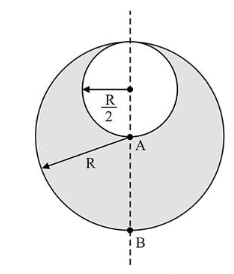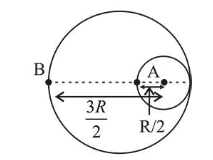Consider a sphere of radius $R$ which carries a uniform
charge density $\rho$. If a sphere of radius $\frac{\mathrm{R}}{2}$ is carved out
of it, as shown, the ratio $\frac{\left|\overrightarrow{\mathrm{E}}_{\mathrm{A}}\right|}{\left|\overrightarrow{\mathrm{E}}_{\mathrm{B}}\right|}$ of magnitude of electric
field $\overrightarrow{\mathrm{E}}_{\mathrm{A}}$ and $\overrightarrow{\mathrm{E}}_{\mathrm{B}}$, respectively, at points $\mathrm{A}$ and $\mathrm{B}$ due to the remaining portion is:

Correct Option: , 2
(2) Electric field at $\mathrm{A}\left(R^{\prime}=\frac{R}{2}\right)$
$E_{A} \cdot d s=\frac{q}{\varepsilon_{0}}$
$\Rightarrow \vec{E}_{A}=\frac{\rho \times \frac{4}{3} \pi\left(\frac{R}{2}\right)^{3}}{\varepsilon_{0} \cdot 4 \pi\left(\frac{R}{2}\right)^{2}}$
$\Rightarrow \vec{E}_{A}=\frac{\sigma(R / 2)}{3 \varepsilon_{0}}=\left(\frac{\sigma R}{6 \varepsilon_{0}}\right)$

Electric fields at ' $B^{\prime}$
$\vec{E}_{B}=\frac{k \times \rho \times \frac{4}{3} \pi R^{3}}{R^{2}}-\frac{k \times \rho \times \frac{4}{3} \pi\left(\frac{R}{2}\right)^{3}}{\left(\frac{3 R}{2}\right)^{2}}$
$\Rightarrow \vec{E}_{B}=\frac{\sigma R}{3 \varepsilon_{0}}-\left(\frac{1}{4 \pi \varepsilon_{0}}\right) \frac{(\sigma)}{\left(\frac{3 R}{2}\right)^{2}} \frac{4 \pi}{3}\left(\frac{R}{2}\right)^{3}$
$\Rightarrow \vec{E}_{B}=\frac{\sigma R}{3 \varepsilon_{0}}-\frac{\sigma R}{54 \varepsilon_{0}}$
$\Rightarrow E_{B}=\frac{17}{54}\left(\frac{\sigma R}{\varepsilon_{0}}\right)$
$\left|\frac{E_{A}}{E_{B}}\right|=\frac{1 \times 54}{6 \times 17}=\left(\frac{9}{17}\right)=\frac{9}{17} \times \frac{2}{2}=\frac{18}{34}$
Click here to get exam-ready with eSaral
For making your preparation journey smoother of JEE, NEET and Class 8 to 10, grab our app now.
